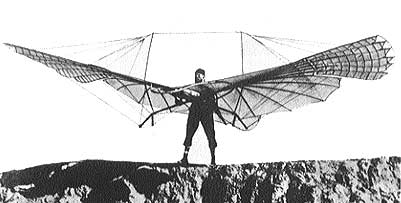
Otto Lilienthal attempting flapping flight in 1894.
http://www.lilienthal-museum.de/olma/ewright.htm
Biomimetic and Bioinspired Propulsion
The natural world boasts a wide variety of highly effective propulsion systems suitable for an assortment of propulsion tasks (see the discussion on biological propulsion). This has led many engineers to develop designs that mimic or emulate key features of biological propulsion systems in order to gain the advantages they enjoy. A familiar example is the early attempts at powered flight that utilized flapping wing designs.

Otto Lilienthal attempting flapping flight in 1894.
http://www.lilienthal-museum.de/olma/ewright.htm
While these attempts at large-scale flapping-wing devices were unsuccessful, many researchers are again looking to bird flight for clues to better designs for small-scale airplanes similar to birds. The hope is that designs incorporating aspects from bird flight will produce micro aerial vehicles (or MAVs, which are aircraft with wingspans less than 6 in.) that are more efficient or maneuverable than traditional designs have been able to muster. Likewise, engineers are gaining insight from a variety of underwater creatures in their efforts to develop underwater vehicles with increased efficiency, maneuverability, and/or stealth.
Mechanical propulsion systems derived in some way from biology are said to be "biomimetic" or "bioinspired," depending on the level of fidelity to the original biological system. Although it is difficult to draw a sharp line between the classifications, one may generally say that biomimetic designs attempt to exactly mimic the geometry and motion of the model biological system, whereas bioinspired designs focus on emulating key features of a biological system that give it a particular performance advantage without mimicking every detail. Regardless of the classification, the objective is still the same, namely, to utilize features of a biological propulsion system to obtain performance advantages that have not or cannot be achieved with traditional propulsion designs.
Current interest in bioinspired and biomimetic propulsion started to take off in the 1990s, and is currently an active area of research among scientists and engineers. In this section we will review a few non-traditional propulsion system designs that share similarities with biological systems in order to illustrate the biomimetic/bioinspired design approach.
Other examples forthcoming
